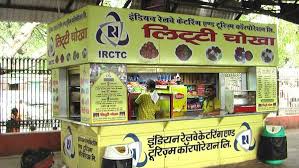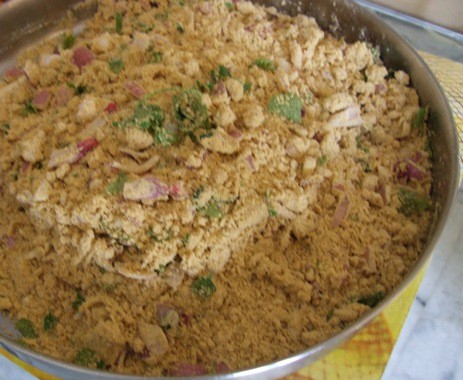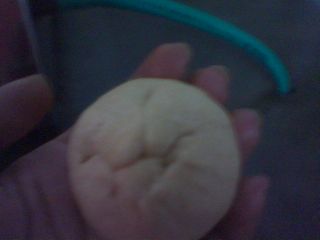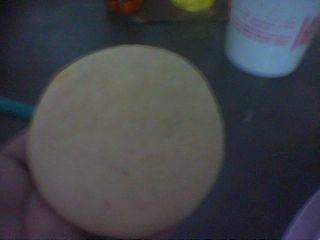i have often been questioned about Sattu in Chennai that is every time i have sattu ka paratha to offer to my guests. Surprisingly i have to exhibit the flour every time my explanation fails to give them a clear picture of sattu. This when they have their very own pottukadalai with which they prepare their chutneys every day to go with their dosas and idlis. Pottukadalai is Tamil for the dry roasted gram or chana dal/ Indian Chickpeas. So i have to explain to them that this pottukadalai or de-husked gram/chickpeas is pulverised to convert them into powder form to get a flour which is called sattu in Hindi. It is a major culinary revelation and mostly my guests ask me for the recipe.
However it becomes imperative to explain the difference between gram flour ie besan and sattu because at the outset both look the same.
The difference being that whereas besan is the flour of raw gram, sattu is the flour of the roasted gram and may look slightly coarser than besan.
The teacher in me does not miss the opportunity to explain that besan is raw gram flour only , but sattu is prepared not only of roasted gram but many other cereals.
So in Bihar we not only have gram sattu but also corn/maize/makai sattu, barley/jau sattu and of late because of it's intrinsic value as a health food manufacturers have started preparing sattus like jaljira mix sattu, nimbupudina sattu mix etc to make it even more delectable and easy to prepare .
In fact the standard sattu that was forced as a staple breakfast item or as a drink to us was a mix of 2/3 of fresh roasted chana and 1/3 fresh roasted barley.
The dinner/lunch conversation now sees me once again taking centre stage at a surprised barrage of questions ,"As breakfast..and how is that drink...is it sweet...???"
Of course i am passing through that phase when everything and anything becomes a narration, nostalgic but now with a renewed sense of pride.
Memories of how easily we replaced sattu as a staple breakfast item with bread and butter come flooding back. Just like how kids today would make a bee-line for pizza, pasta, burgers and last but not the least Maggi so did we clamor for toast and jam instead of our own nutritious local delicacies.
Just like the kids of today these were not delicacies at all...they were just some rustic, local grub discarded from the palate with a frown that proclaimed distaste and dislike.
As kids we would watch relatives on the table mix sattu with a little bit of water and salt and knead it softly to prepare a big ball of dough. Then they would divide the dough into smaller balls as they popped these balls into their eager mouths and ate with relish their favourite breakfast snack with pickle, onions and fresh green chillies.
Once in a while when it looked tempting we would reach out for these balls but nevertheless bread, butter, jam dominated our palates.
i remember the fuss created when this gruel of fresh sattu in hot milk was offered to us. Sometimes as a drink and sometimes as porridge with mashed bananas, jaggery/sugar and a bit of crushed cardamom for added flavour. This during the winters.
During summers sattu was mostly consumed as a cooling drink. One could have it either with salt or with sugar as one preferred.
A tablespoon of sattu mixed in a glass of cold water into which a dash of lemon juice and salt is added can be a cool refreshing drink that not only energises but also takes care of the small hunger that one may experience in between meals.
Alternatively this drink could be a sweet one if instead of salt, sugar/jaggery is added. If this had to be made richer still with more added calories then instead of plain water sattu was mixed into cold milk or hot milk as one preferred it.
Today i explain with enthusiasm not only about the secret ingredient which went into making these exotic and delectable parathas sitting invitingly on my table but also about the medicinal value of that secret ingredient. That apart from it being a nutritious drink it helps to combat acute gas problems and even constipation.
Considered earlier to be a poor man's food, i still remember the road side stalls piled high with conical mountains of different varieties of sattu in large aluminium plates with turned corners. Not the regular stalls that we see these days but a shaded area maybe under a tree or else a make shift shade created with four bamboo poles and canopied with jute sacks that gave it a tent like appearance.
These stalls were the dining cafes of poor labourers, richshaw pullers who could afford only sattu for their lunch or dinner. The balls that i just talked about was eaten with onions and green chillies and when the purse allowed, a small plate of any vegetable curry or simple potato fry that the stall owner had prepared for the day.
Sometimes when they had earned well enough they would be seen eating yet another item with the curry of the day.This was litti. A baked ball of wheat dough stuffed with sattu masala.
Now those stalls have vanished into thin air and sattu is no longer the cheapest item.
What is still surprisingly new is the sudden appearance of kiosks and mobile vendors selling litti chokha which are approached by one and all. In fact you could now grab a bite of litti chokha at all major stations in Bihar.
Sattu has a low shelf life and although can be stored in the freezer, it tastes excellent when it is fresh. It is the main ingredient that is used as the stuffing for litti and sattu ka paratha.
i have not tampered with the sattu stuffing in my attempt to get innovative. So the basic stuffing masala for both remains traditional which is :
- 1 cup Sattu (Gram Flour)
- 4 pods Garlic (finely chopped)
- 1 " Ginger (finely chopped)
- 2-3 Green chilies (chopped)
- Finely chopped coriander leaves
- 2 tbsp Masala of Red Chilli Pickle or mango pickle
- 1/2 tsp Onion Seeds (Nigella seeds)
- 1 tsp Ajwain (thyme seeds)
- 1 tsp Lemon Juice
- Salt to taste
- ¼ to ½ Cup Water (to make the stuffing moist and easy to fill.)

What makes my parathas unique is the slight change in the way i prepare my dough.
Ordinarily wheat flour is kneaded with yoghurt or just plain water to prepare a soft dough. My dough needs the following :
The wheat flour and maida flour is mixed evenly along with all the dry items. Then a well made into this mix into which we pour the cooking oil. The flour is mixed again using the fingers before being kneaded into a soft dough using the yoghurt or the milk water mix. The dough when ready will not stick on the fingers and will look as soft as a baby's bottom. The rest of the procedure is the same as we prepare aloo parathas. First make a cup out of the flour dough, as shown in the picture below   Finally press the ball gently to flatten it a bit, as shown below  After this the choice is yours. Which is... either you can roll it into rotis and fry it on a griddle with cooking oil or ghee (clarified butter) to make sattu ka parathas or if the craving is to eat litti then just bake these slighty flattened balls in a hot oven. The littis when done would have dark brown spots and might look cracked. Which is best because then they soak up the clarified butter ie ghee even better. If not then it is broken open with slight pressure using both hands before dipping them in a bowl of melted ghee. Both these items taste great with mutton curry however the basic vegetarian side dish that tastes yummy with litti or sattu ka paratha is chokha or bhartha. So now for the chokha :
|

Then it is allowed to cool and the burnt skin is removed carefully. Similar procedure for the tomatoes too.The roasted brinjal/aubergine, tomatoes, and boiled potatoes are then mashed properly till there are no lumps. Now the rest of the ingredients are added and mixed thoroughly. The chokha or bhartha should look like this:


So far as litti and sattu parathas is concerned i must however remember to point out that since these dishes are made rich using lots of clarified butter or ghee to achieve the perfect taste it does induce extra thirst at times.
i am sure that it is not unusual to crave local dishes when you are away from your homeland for a real long time. i guess it is the absence or a lack of it for a substantial period of time that creates the sudden craving. For what is easy and commonly available we won't even bother. Further to develop appreciation for both local cuisine and culture a particular mature age is needed. After having been there and eaten that...
i still see the same thing happening around me and it's like history repeating itself.
So to all my friends who have kids fussing and creating a ruckus over local cuisine and asking for burgers and pizzas i always have the same thing to say.
" Let them fly out of your nest and you'll see them asking you for your regular dal, even greens, and all the regular local grub when they come back during semester breaks...have patience. Wan't it the same when we were young?..."
The look of irritation evaporates and nostalgia sees us smiling and comparing notes of forgotton foods and many many more.
.jpg)



Very appetizing photos you have posted. Never heard about ‘litti chokha’, but then every post of yours has been a learning experience for me personally. Thanks Shivani.
ReplyDeleteI and my wife endorse your last part of the post 100%. My boys have been away since last four years. They yearn for home food whenever they come to Bahrain during their end semester periods. And do they do justice??? Well you have to see them eating.
It’s really strange when you see history repeating itself. Life is definitely a circle.
@Tandarin thanks for reading and endorsing my views about forgotton foods.
ReplyDeletei had to do this post because i promised in my last post about more.
In any case thanks to the internet and people like me who want to share local cuisines you will find many blogs which have posted both LIITI AND SATTU KA PARATHA...that is if u are interested.
Thanks also for finding my posts'a learning experience' but it's also same for me too.
i get insights from your posts.:)
whole thing is so yummy.feel like having right now.i suppose this is Bihar ka delicacy...
ReplyDeleteI am saving this post as yr innovations are always a big hit.Do u know why? coz there is only one ingredient in it and that is LOVE.
ReplyDeleteit is great write up abot litti.keep it up
ReplyDelete@ Anonymous sure it is made in both Bihar and U.P.
ReplyDeleteYup it is delicious especially when you have it during winters and even when it is raining and you want to have something chatpata.
Thank you for reading.
@Gauri thank you deary...yeah my attempt to create something which has my own was appreciated as the dough i prepare turns out to be even more khasta.
ReplyDeleteNothing original though...applied some from here and there.
Love has to be the one and most important ingredient in any Ghar ka Khana that's why one returns to it i think after eating at the best joints.
Finally you want your Ghar ka Khana...hai na!!
Thanks for appreciating and for reading.:)
@Chandra Vir thank you Lali for taking time out to first read and then comment on it.
ReplyDeleteAnd if you have patience and the time you can check out the links and you will know that i was not the first or the best.
Just wanted you to know before you started giving me too many credits. :)
shivani, great patience in explaining the details of litti cnokha and parathas. It is very mouth wateing and makes me want to make them. I esp. want to try your dough recipe - i have never made dough with all that flavors and yogurt- i am so excited to try it. Also btw the pictures were very good and shows how good cook you are- they looked perfect indeed!!
ReplyDelete@Mini yeah since we are Biharis Sattu is no big deal for us but for many from outside it is something that has to be explained and i tried to do my bit at scattering the information i had.
ReplyDeleteMy dough will give you a more khasta Paratha with added flavours.Also it is a nice change from the regular.
Hope u and family find it better than the usual.
Thanks on ur patience too for going through what you already knew.
BTW most pics are lifted from the net except one which shows the plate with accompaniments on the table ie the 4th picture.
Thanks on ur appreciation nevertheless.
Bon appetit :)
Thanks a lot for the recipe. your description is very clear...Dr. Avanjali Satapathy
ReplyDelete@Avanjal thank you dear friend for going through my blog and i hope you find it useful enough. :)
ReplyDeleteThank you Shivani...............very enlightening..........i had a first taste of this in the streets of Ranchi............i liked Sattu so much and i bought a packet of it from the grocery shop. Now is this available in Chennai? is it simple Pollukalai Mavvu? we get Poddukalai in Chennai........can we buy this and grind it in a mixie?
ReplyDeletePlease let me know.
@asokmercuri mani...welcome to my page and thanks a lot for stopping by to go through my exhaustive thoughts on Sattu.
ReplyDeleteNow for ur question...sure sattu is nothing but poddukalai mava(dry)and yes whenever i would exhaust my supply from Patna i used to grind poddukadalai and make my parathas...try it if u can and even a strict sattuaite may not know the difference.
The difference being in the local variety of small black gram which has a better taste than the large ones generally used as poddukadalai. The difference akin to Kabuli Chana which is used for cholay and the small chana that we normally soak overnight and eat as sprouts.
Bon apetit! and hope to see more of you.
IS there any place in Chennai Where I can get some sattu, My sattu supply is finished for the moment and am at a loss, please help :(.
ReplyDeletecould you let me know whether sattu is available in chennai off the shelf in dept stores like nilgiris/spencers/nuts and spices?
ReplyDeleteGreat writeup!
ReplyDeleteWow, great writeup and recipes discovered while searching for the difference between sattu and besan. Profound thanks. And you hit the nail accurately on the longing for long-ago foods you can't get locally. Been there.
ReplyDeleteI could relate to your post so much. When I used to live at home sattu was hardly something I'd ever crave for, barring the occasional desire for satru sherbet during summer months. But now that I've moved out, there's a special place in my heart for sattu be it the parathas or even as thick sweet sattu porridge. Really enjoyed reading.
ReplyDeleteIf i roast besan does it become sattu?
ReplyDeleteDear Yashasvi i sincerely think that however logical it may sound yet when u roast besan it smells nice and may taste better than raw besan but even then it will not taste like sattu. The process of preparing sattu imparts a special flavor besides besan is very fine and sattu is coarser because it also contains in micro granules the roasted skin of the chickpeas.
DeleteTexture and flavor both matter.
There are channels on YouTube which can teach you to prepare sattu and maybe you can try.
In fact get a packet of roasted China with skin and make a coarse powder in the mixie. It will be very close to sattu.
sdfsd
ReplyDelete